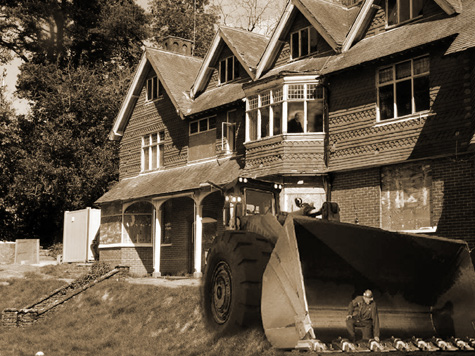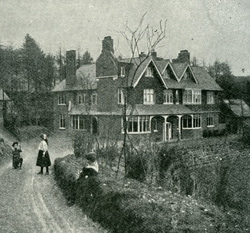“A door opened and shut. An instant later, steps crept down the passage – steps which were supposed to be silent, but which reverberated harshly through the empty house….”
The Empty House was published in 1903, the first of the so-called “Return of Sherlock Holmes” stories which were written after Conan Doyle had already killed off his famous detective at Reichenbach Falls, only to be forced to bring him back to life again, such was public demand for the eccentric detective with the cape and the deerstalker hat.
And today the image of Sherlock Holmes has gone stratospheric with blockbuster movies starring Robert Downey Junior from Hollywood and the equally successful Sherlock series from the BBC, featuring the suavely dressed—if improbably named—Benedict Cumberbatch. Both new outings for Conan Doyle have enjoyed massive international success, which is a testament to the longevity and genius that is Sherlock Holmes.
Last week, I went on a literary pilgrimage to a rambling manor house called Undershaw House. The very name “Undershaw” conjures the rustle of silk across a parquet floor, a Grandfather clock chiming in an echoing hallway, and—in the balmy air—the sweet scent of lavender breezing through an opened window. Even, perhaps, the sudden and gregarious trill of a blackbird.
Undershaw, in Hindhead, was the residence of Sir Arthur Conan Doyle. Built in 1897 and designed by Doyle himself (with more than just a nod to late Victorian fashions for high gothic), it’s set in an elevated spot in an area known back then as “Little Switzerland.” Doyle chose this particular location for his new home because he believed that the fresh breezes of this hilly part of Surrey would cure his poor wife, Louise, of her ill health. Louise suffered from the terrible disease of consumption (or as we now call it, TB).
Whilst Undershaw is a handsome house, it’s not deemed architecturally distinguished enough to earn the right to be preserved by the likes of the National Trust or English Heritage, charities dedicated to saving important British buildings and estates. Which is a problem, because forces of evil are at work, casting a looming shadow over the house darker than the mind of Moriarty, and threatening the very integrity and survival of Undershaw.

Property developers want to develop Undershaw for profit, turning it into a series of luxury flats. And so the race is on to save Undershaw. As I write there is a judicial review underway to discuss the future of Undershaw and its true monetary value. The review will be concluded in May and then, as to the house’s future, who knows?
Meanwhile, forces of good have gathered themselves into a campaign to save Undershaw. This group is supported by actors, academics, writers, historians and descendents of the Conan Doyle family, who, quite rightly, want Undershaw turned it into a Museum and visitor’s centre for Sherlock Holmes fans, everywhere. And of particular interest to authors like myself, there are aspirations to turn Undershaw not only into a shrine to Conan Doyle, but also a living creative hub for writers to come and work, exploring their genre and honing their craft.
Crime writing is the most popular genre today and even in recession, we are told it’s growing fast. Let’s hope so. I am all for buoyant book sales and so it seems to be, “elementary, my dear Watson” (though Holmes fans would never use such a non-canonical phrase) to preserve Undershaw as a mecca for lovers of Sherlock. And this would be a far better an outcome surely, than the plans which are underway by the faceless property developers who have bought the estate, and who are intent on making a vast profit, by turning this evocative place into a number of bijou residences for commuters, silver surfers, or whatever.
Sorry.
I don’t mean to sound like a literary snob but aren’t there are enough of those sorts of places already? It’s really hard to believe that the local Council is so short sighted that it’s seriously considering sacrificing over a hundred years of our literary heritage just to pave the way for yet more bland, suburban living spaces.
But alarmingly, it would appear so.
Whilst the property developers in question claim they would not alter the exterior look of the house (which is quite breathtaking with its red brick facade, huge windows, and gothic turrets), the interior would be in the firing line as the diggers moved in. The plan is to pull it apart (they say “reconfigure”) the elegant interior, which flows currently as an Edwardian home, into twelve or more flats.
Urrrggh.
A sign of things to come, I think, when I’m told by Raks Patel of The Undershaw Allliance that a beautiful stained glass window, with the family crest engraved on it, has already been partly destroyed by vandals and for its own safety, has had to be removed to an unspecified location.
Sadly, I couldn’t gain entry to the house. But watch this clip and weep, Sherlock fans:
The estate is now surrounded by commuter belt overspill and the distant burr of traffic coming from the A3. Nevertheless, as I sat on the stones steps which lead down into what can only be described as a fairy dell of a rolling garden, I felt strangely nestled by nature. All around me were resilient shrubs, sky-high pines and other magnificent trees and I could immediately understand why Conan Doyle had been able to write his great works here, of all places. It’s very serene but at the same time inspiring. My eyes were drawn to the scudding clouds overhead, and I could sense, amongst all these whispering leaves, how a writer could have the mental space to think and most importantly, to imagine. This is certainly what I crave on a daily basis, as I write my own series.
It was here at Undershaw that Conan Doyle produced some of his greatest works, including my personal favourite, the gothic masterpiece, The Hound of the Baskervilles, and I suppose the mystery is how this grand yet forlorn-looking building became so neglected in the first place.
Today, Undershaw has an air of melancholy with its broken windows, boarded up doors, chipped and yellowing woodwork. Beneath my feet, in addition to cigarette ends and discarded sweet wrappers, I could see a thousand tiny shards of glass littering what must have been the most intricate herringbone brick work, now sullied and overgrown with rusty-coloured moss and feathering bindweeds. But what really upset me, as I wandered around Undershaw’s extensive grounds, were the signs nailed up everywhere, in that officious and municipal CAPITAL LETTERING property developers are so enamoured with, warning trespasses like me, because I had no permission to be there, “Oi you! Woman in the buttoned up coat”…. “DANGER: KEEP OUT!”

It’s a crying shame that we might lose this house. That it will be wrecked from the inside and have its soul stripped out. I really hope this doesn’t happen. I think this would be a crime against our literary heritage.
There are countless examples of successful writers homes which have been saved for posterity and become wonderful places for all of us to visit.
- Bateman’s in Hampshire (Rudyard Kipling’s House – http://www.nationaltrust.org.uk/batemans);
- Charles Dickens’s home in London (http://www.dickensmuseum.com/) and
- Henry James’s home in Rye, to name but a few (http://www.nationaltrust.org.uk/lamb-house).
With our help, as crime fiction writers and readers, Undershaw can be saved.
And my parting message to those greedy property developers and the short-sighted Council who have Undershaw’s future in their hands? Well , I could do worse than to quote Conan Doyle again, from the aptly named short story The Darkest Hour:
“Give it up, Jack. For my sake, for God’s Sake, give it up!”
For more information, on the campaign to save Undershaw House, please visit the Save Undershaw Preservation Society for access to their wonderful pictures.
With special thanks to the Undershaw Alliance and Raks Patel for arranging my visit. They don’t have a website yet, but perhaps soon!
D.E. Meredith is the author of the historical crime series The Hatton and Roumande Mysteries, featuring the first forensic scientist, Professor Adolphus Hatton, and his trusty French morgue assistant, Albert Roumande. She was thrilled when someone compared her work to Doyle’s.

How devastating to know that the history of this beautiful home may soon be altered, that it’s very core may be torn asunder. It is with sorrow that I read your article and, like you, I am dismayed that the historical society did not see fit to protect Sir Arthur Conan Doyle’s home as part of his legacy.
The Undershaw Alliance now has a website, which can be found here: http://www.undershawalliance.com/
Please do check us out and join our campaign to save Undershaw for the Nation by relaunching it as the Conan Doyle Museum and Centre for British and Irish Crime Writing, thus affirming its cultural value and Conan Doyle’s place in the literary heritage of Great Britain and Ireland, and beyond.
Glad to explore about the house history on your blog these are quite impressive and acknowledging. These houses can be transformed into beautiful places with a rich history and a unique aesthetic appeal. They can be a great subject for photography, especially for those interested in capturing the beauty of decay and the passage of time.